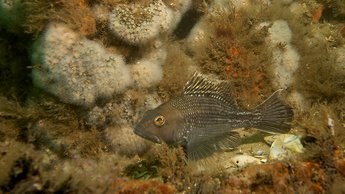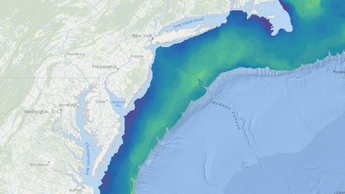New Fish Biomass Time Series Sliders and Maps Showing Potential Vulnerability of Fish Species to EMF
Over the past year, the Marine life Data & Analysis Team (MDAT) and the Northeast Regional Ocean Council (NROC)-Mid-Atlantic Regional Council on the Ocean (MARCO) Marine Life Fish Work Group collaborated on new fish biomass data products derived from the NOAA Northeast Fisheries Science Center (NEFSC) bottom trawl database. These new fish time series sliders and maps showing distributions of fish species that are potentially vulnerable to electric and magnetic fields (EMF) are now available in Marine Planner and can be downloaded from the Portal’s Data Catalog.
Fish Biomass Time Series Sliders
In the fall of 2021, the MDAT and Fish Work Group developed updated data products from the NEFSC trawl that depict spring and fall fish biomass from the most recent complete decade – 2010-2019. The new time slider data products released today complement these products by depicting several previous decades of NEFSC trawl data. Layers in the time slider represent average total biomass from 1980-1989, 1990-1999, 2000-2009, 2010-2014 and 2015-2019. The changeover to five-year increments was implemented to add greater temporal resolution to recent time periods supporting current management decision making. Symbology for each species group was determined by the distribution of values from the most recent decade and applied to all time steps in the series, allowing comparisons between seasons and decades within a given species group. These new layers were created for the species groupings: All Fish Species, Demersal Fish, Diadromous Fish, and Forage Fish.
The new maps can be accessed in the Portal’s Marine Life theme by clicking on the “Fish Time Series Sliders: 1980-2019 (Spring and Fall)” dropdown. Select the maps of interest (e.g. All Fish Species: Biomass 1980-2019, Forage Fish: Biomass 1980-2019) and then click the “View Slider” button to control them in the Active tab. There you can manually toggle through the slider bars to view the fish data by decade and season, or click the play icon to automatically animate the maps.

New Stressor Group Summary Data Product for Fish Potentially Vulnerable to EMF
The Fish Work Group was asked to consider developing new data products related to fish species’ potential vulnerability to EMF associated with submarine power cables. The Work Group used the list of species in the 2019 BOEM study “Evaluation of Potential EMF Effects on Fish Species of Commercial or Recreational Fishing Importance in Southern New England” to map the total biomass and species richness in spring and fall of a new group called “Potentially Vulnerable to EMF.” The list includes pelagic and demersal species that are known to have electric or magnetic senses (e.g., skates and sharks) and those that likely do not have these senses but may be exposed to EMF due to their habitat use. The BOEM report concluded that regardless of the likelihood of exposure to EMF, negligible or no negative effects from EMF exposure are anticipated for these species.
These new layers can be accessed in the Marine Life theme by clicking on the “Fish – Spring 2010-2019” or “Fish – Fall 2010-2019” dropdown and selecting Potentially Vulnerable to EMF: Biomass, Potentially Vulnerable to EMF: Species Richness, or Potentially Vulnerable to EMF: Core Biomass.

Share this story